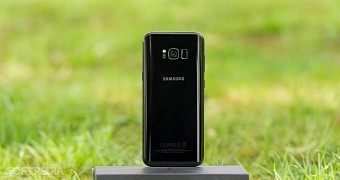Now that the iPhone X is already on the market, it’s Samsung’s turn to take the innovation lead with the Galaxy S9, but according to a report, the South Korean phone maker might not meet market expectations when it comes to breaking features on its upcoming device.
Business Korea writes, via sources familiar with the matter, that the Galaxy S9 will come in two sizes just like the existing lineup, namely the regular model with a 5.8-inch display and the Plus-sized version with 6.2 inches.
The biggest innovation on the iPhone X is the Face ID facial recognition system which uses 3D sensing cameras to scan users’ faces and unlock the device. Samsung is already offering such features on the Galaxy S8 series, but as compared to rival Apple, it’s using 2D face recognition that costs less, but is also less secure.
It turns out that the Galaxy S9 will feature a mix of 2D and 3D technology, as the company reportedly wants to avoid “the technological limitations” that Apple experienced with the latter. This means 2D facial recognition will be used for some tasks, while the 3D system will be available for others, like unlocking the device.
Dual-camera system also on its way
Major upgrades, however, are still planned for the Galaxy S9. The source says Samsung will use a dual-camera system with 3-stack layer image sensor, which should be able to take more than 1000 images per second. This is a feature specifically aimed at professional photographers and will substantially enhance the manual mode.
On the other hand, this is expected to generate a price increase, though it’s highly unlikely for the Galaxy S9 to become as expensive as the iPhone X, which costs $1,149 for the 256GB storage version.
"When Samsung Electronics applies 3-stack layer laminated image sensors to smartphone cameras next year, the ASP of camera modules will double or triple to US$ 60 to US$ 90 due to the installation of super high-priced image sensors, camera module parts and design changes among others,” Kim Dong-won, an analyst at KB Securities, told the source.
According to the report, Samsung is aware that the Galaxy S9 doesn’t meet the market expectations in terms of innovation level, but the firm appears to be ready to deal with the criticism, claiming that it wants to “enhance the completeness of the Galaxy S8 hardware and an innovative user experience (UX).”
The device is expected to launch in early 2018, and Business Korea says it’s likely this will happen at the MWC in February, despite Samsung being known as a company that holds separate press events for its flagship smartphones.

 14 DAY TRIAL //
14 DAY TRIAL //